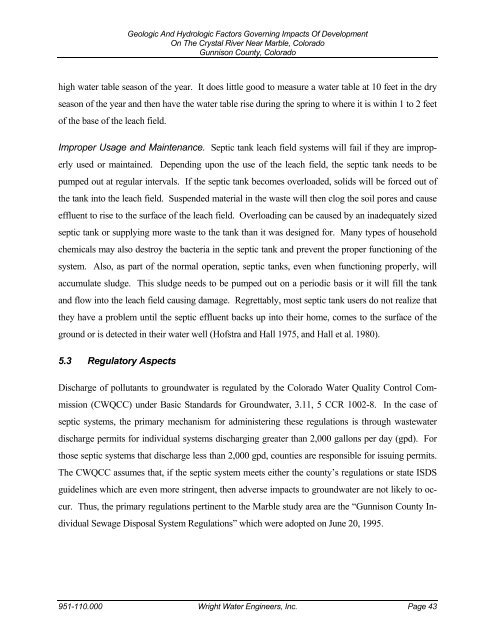Geologic And Hydrologic Factors Governing ... - Gunnison County
Geologic And Hydrologic Factors Governing ... - Gunnison County
Geologic And Hydrologic Factors Governing ... - Gunnison County
Create successful ePaper yourself
Turn your PDF publications into a flip-book with our unique Google optimized e-Paper software.
<strong>Geologic</strong> <strong>And</strong> <strong>Hydrologic</strong> <strong>Factors</strong> <strong>Governing</strong> Impacts Of Development<br />
On The Crystal River Near Marble, Colorado<br />
<strong>Gunnison</strong> <strong>County</strong>, Colorado<br />
high water table season of the year. It does little good to measure a water table at 10 feet in the dry<br />
season of the year and then have the water table rise during the spring to where it is within 1 to 2 feet<br />
of the base of the leach field.<br />
Improper Usage and Maintenance. Septic tank leach field systems will fail if they are improp-<br />
erly used or maintained. Depending upon the use of the leach field, the septic tank needs to be<br />
pumped out at regular intervals. If the septic tank becomes overloaded, solids will be forced out of<br />
the tank into the leach field. Suspended material in the waste will then clog the soil pores and cause<br />
effluent to rise to the surface of the leach field. Overloading can be caused by an inadequately sized<br />
septic tank or supplying more waste to the tank than it was designed for. Many types of household<br />
chemicals may also destroy the bacteria in the septic tank and prevent the proper functioning of the<br />
system. Also, as part of the normal operation, septic tanks, even when functioning properly, will<br />
accumulate sludge. This sludge needs to be pumped out on a periodic basis or it will fill the tank<br />
and flow into the leach field causing damage. Regrettably, most septic tank users do not realize that<br />
they have a problem until the septic effluent backs up into their home, comes to the surface of the<br />
ground or is detected in their water well (Hofstra and Hall 1975, and Hall et al. 1980).<br />
5.3 Regulatory Aspects<br />
Discharge of pollutants to groundwater is regulated by the Colorado Water Quality Control Com-<br />
mission (CWQCC) under Basic Standards for Groundwater, 3.11, 5 CCR 1002-8. In the case of<br />
septic systems, the primary mechanism for administering these regulations is through wastewater<br />
discharge permits for individual systems discharging greater than 2,000 gallons per day (gpd). For<br />
those septic systems that discharge less than 2,000 gpd, counties are responsible for issuing permits.<br />
The CWQCC assumes that, if the septic system meets either the county’s regulations or state ISDS<br />
guidelines which are even more stringent, then adverse impacts to groundwater are not likely to oc-<br />
cur. Thus, the primary regulations pertinent to the Marble study area are the “<strong>Gunnison</strong> <strong>County</strong> In-<br />
dividual Sewage Disposal System Regulations” which were adopted on June 20, 1995.<br />
951-110.000 Wright Water Engineers, Inc. Page 43



